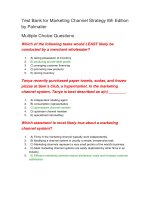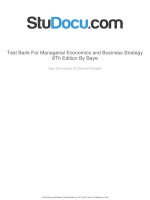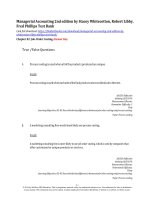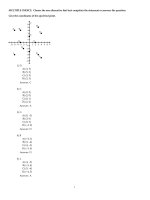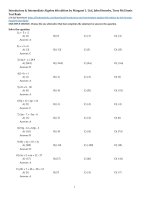Managerial economics and business strategy 8th edition by baye and prince test bank
Bạn đang xem bản rút gọn của tài liệu. Xem và tải ngay bản đầy đủ của tài liệu tại đây (851.88 KB, 62 trang )
Managerial Economics & Business Strategy 8th edition by Michael R. Baye, Jeffrey T. Prince
Test Bank
Link full download: />Chapter 06. The Organization of the Firm Answer Key
Multiple Choice Questions
Often owners of firms who hire managers must install incentive or bonus plans to ensure that
the:
A. company is financially secure.
1.
B. manager will work hard.
C. manager will maintain employee morale.
D. company will have positive economic profits.
AACSB: Reflective Thinking
Blooms: Understand
Difficulty: 2 Medium
Learning Objective: 06-04 Describe the principal-agent problem as it relates to owners and
managers.
Topic: Managerial Compensation and the Principal-Agent Problem
Which of the following forms of payment is NOT an incentive plan?
A. Commission plans for salesmen
2.
B. Flat salary for a plant manager
C. Bonuses for managers that increase as profits increase
D. None of the statements is correct.
AACSB: Reflective Thinking
Blooms: Understand
Difficulty: 2 Medium
Learning Objective: 06-05 Discuss three forces that owners can use to discipline managers.
Topic: Managerial Compensation and the Principal-Agent Problem
Which of the following is NOT an incentive scheme to ensure that workers do a good job?
3.
A. Paying waitresses low wages, but allowing them to collect tips
B. Profit-sharing plans in large companies
C. Commission pay schedules for salesmen
D. Straight hourly wages for dock workers
AACSB: Reflective Thinking
Blooms: Understand
Difficulty: 1 Easy
Learning Objective: 06-06 Describe the principal-agent problem as it relates to managers and
workers.
Topic: The Manager-Worker Principal-Agent Problem
Which of the following is NOT a means of avoiding opportunism?
A. Contracts
4.
B. Spot exchange
C. Vertical integration
D. Long-term contracts
AACSB: Reflective Thinking
Blooms: Understand
Difficulty: 2 Medium
Learning Objective: 06-03 Explain the optimal manner of procuring different types of inputs.
Topic: Optimal Input Procurement
Long-term contracts become longer:
A. when specialized investment becomes more important.
B. when the exchange environment is more complex.
5.
C. when spot markets work well.
D. when marginal costs are declining.
AACSB: Analytic
Blooms: Analyze
Difficulty: 3 Hard
Learning Objective: 06-03 Explain the optimal manner of procuring different types of inputs.
Topic: Optimal Input Procurement
A relationship-specific exchange occurs when:
A. a partnership is dissolved.
6.
B. specialized investments are important.
C. a partnership is initiated.
D. shareholders receive dividends.
AACSB: Reflective Thinking
Blooms: Understand
Difficulty: 1 Easy
Learning Objective: 06-03 Explain the optimal manner of procuring different types of inputs.
Topic: Optimal Input Procurement
When relationship-specific exchange occurs in complex contractual environments, the best
way to purchase inputs is through:
A. spot markets.
7.
B. vertical integration.
C. short-term agency agreements.
D. long-term contracts.
AACSB: Reflective Thinking
Blooms: Understand
Difficulty: 1 Easy
Learning Objective: 06-03 Explain the optimal manner of procuring different types of inputs.
Topic: Optimal Input Procurement
A firm might choose to produce its own inputs if:
A. specialized investment is not important.
8.
B. long-term contracts are costly to write.
C. the exchange environment is not complex.
D. spot markets for the input exist.
AACSB: Reflective Thinking
Blooms: Understand
Difficulty: 2 Medium
Learning Objective: 06-03 Explain the optimal manner of procuring different types of inputs.
Topic: Optimal Input Procurement
An agent hired by the owner of productive resources to control the production process is:
A. a laborer.
B. a self-proprietor.
9.
C. an assembly worker.
D. a firm manager.
AACSB: Reflective Thinking
Blooms: Remember
Difficulty: 1 Easy
Learning Objective: 06-04 Describe the principal-agent problem as it relates to owners and
managers.
Topic: Managerial Compensation and the Principal-Agent Problem
Spot exchange can be inefficient in the presence of:
A. opportunism.
B. a complex contracting environment.
10.
C. spot checks.
D. None of the statements is correct.
AACSB: Reflective Thinking
Blooms: Understand
Difficulty: 2 Medium
Learning Objective: 06-01 Discuss the economic trade-offs associated with obtaining inputs through
spot exchange; contract; or vertical integration.
Topic: Methods of Procuring Inputs
11.
A negative side of long-term contracts is:
A. high transaction costs.
B. a loss of flexibility.
C. the continual need to renegotiate the contract.
D. None of the statements is correct.
AACSB: Reflective Thinking
Blooms: Understand
Difficulty: 2 Medium
Learning Objective: 06-01 Discuss the economic trade-offs associated with obtaining inputs through
spot exchange; contract; or vertical integration.
Topic: Methods of Procuring Inputs
Spot markets are an efficient way for the firm to purchase inputs if:
A. opportunism is not a problem.
B. suppliers engage in hold-up.
12.
C. profit sharing is used to compensate managers.
D. the supplier needs specialized investment to produce the input.
AACSB: Reflective Thinking
Blooms: Understand
Difficulty: 1 Easy
Learning Objective: 06-03 Explain the optimal manner of procuring different types of inputs.
Topic: Optimal Input Procurement
The disadvantage of vertical integration is that:
A. relationship-specific exchange may cause hold-up.
B. long-term contracts may be inflexible.
13.
C. the principal-agent problem causes shirking.
D. firms no longer specialize in what they do best.
AACSB: Reflective Thinking
Blooms: Understand
Difficulty: 2 Medium
Learning Objective: 06-01 Discuss the economic trade-offs associated with obtaining inputs through
spot exchange; contract; or vertical integration.
Topic: Methods of Procuring Inputs
In the absence of worker incentives:
A. everyone always gives maximum effort.
14.
B. there is a natural tendency for workers to not give their maximum effort.
C. managers have little or no control.
D. None of the statements is correct.
AACSB: Reflective Thinking
Blooms: Understand
Difficulty: 1 Easy
Learning Objective: 06-06 Describe the principal-agent problem as it relates to managers and
workers.
Topic: The Manager-Worker Principal-Agent Problem
A person who monitors the production process and evaluates the productivity of workers is:
A. a manager.
B. an employee.
15.
C. a shareholder.
D. a self-proprietor.
AACSB: Reflective Thinking
Blooms: Remember
Difficulty: 1 Easy
Learning Objective: 06-06 Describe the principal-agent problem as it relates to managers and
workers.
Topic: The Manager-Worker Principal-Agent Problem
A drawback of separating ownership from control by creating a firm is:
A. the losses of specialization.
16.
B. increased transaction costs.
C. the principal-agent problem.
D. synergies of team production.
AACSB: Reflective Thinking
Blooms: Understand
Difficulty: 1 Easy
Learning Objective: 06-04 Describe the principal-agent problem as it relates to owners and
managers.
Topic: Managerial Compensation and the Principal-Agent Problem
Shirking can take the form of:
A. long lunch hours.
B. sleeping at work.
17.
C. leaving work early.
D. All of the statements associated with this question are correct.
AACSB: Reflective Thinking
Blooms: Remember
Difficulty: 1 Easy
Learning Objective: 06-06 Describe the principal-agent problem as it relates to managers and
workers.
Topic: The Manager-Worker Principal-Agent Problem
Which of the following payment plans does NOT give an incentive to a manager to stop
shirking?
A. Flat salary with additional pay based on profits of the firm
18.
B. Pay schedule based solely on profits earned by the firm
C. Flat salary regardless of firm profits
D. None of the statements is correct.
AACSB: Reflective Thinking
Blooms: Understand
Difficulty: 2 Medium
Learning Objective: 06-05 Discuss three forces that owners can use to discipline managers.
Topic: Forces that Discipline Managers
The most likely effect of reducing performance-based rewards for the CEOs of corporations
would be:
A. an increase in profits.
19.
B. a drop in revenues.
C. a drop in profits.
D. an increase in the value of the corporation.
AACSB: Reflective Thinking
Blooms: Understand
Difficulty: 2 Medium
Learning Objective: 06-05 Discuss three forces that owners can use to discipline managers.
Topic: Forces that Discipline Managers
Suppose compensation is given by W = 512,000 + 217π + 10.08S, where W = total
compensation of the CEO, π = company profits (in millions) = $200, and S = sales (in
millions) = $400. How much will this CEO be compensated?
A. $812,431
20.
B. $43,400
C. $559,432
D. $512,000
AACSB: Analytic
Blooms: Apply
Difficulty: 1 Easy
Learning Objective: 06-05 Discuss three forces that owners can use to discipline managers.
Topic: Managerial Compensation and the Principal-Agent Problem
Suppose compensation is given by W = 512,000 + 217π + 10.08S, where W = total
compensation of the CEO, π = company profits (in millions) = $200, and S = sales (in
millions) = $400. What percentage of the CEO’s total earnings are tied to profits of the firm?
21.
A. 8.2 percent
B. 10.9 percent
C. 7.8 percent
D. 5.1 percent
AACSB: Analytic
Blooms: Apply
Difficulty: 2 Medium
Learning Objective: 06-05 Discuss three forces that owners can use to discipline managers.
Topic: Managerial Compensation and the Principal-Agent Problem
An incentive for managers to maximize profits is:
A. reputation.
B. performance bonuses.
22.
C. takeovers.
D. All of the statements associated with this question are correct.
AACSB: Reflective Thinking
Blooms: Remember
Difficulty: 1 Easy
Learning Objective: 06-05 Discuss three forces that owners can use to discipline managers.
Topic: Forces that Discipline Managers
A manager who tries to enhance worker effort by tying workers’ compensation to the
profitability of the firm is using:
A. spot checks.
23.
B. revenue sharing.
C. profit sharing.
D. piece rates.
AACSB: Reflective Thinking
Blooms: Remember
Difficulty: 2 Medium
Learning Objective: 06-07 Discuss four tools the manager can use to mitigate incentive problems in
the workplace.
Topic: The Manager-Worker Principal-Agent Problem
A payment plan that induces better worker effort by linking compensation to revenues of the
firm is known as:
A. revenue sharing.
24.
B. profit sharing.
C. piece rate sharing.
D. spot checking.
AACSB: Reflective Thinking
Blooms: Remember
Difficulty: 1 Easy
Learning Objective: 06-07 Discuss four tools the manager can use to mitigate incentive problems in
the workplace.
Topic: The Manager-Worker Principal-Agent Problem
An example of a job that usually involves a revenue-sharing plan would be:
A. waiters and waitresses.
B. car salesman.
25.
C. insurance agents.
D. All of the statements associated with this question are correct.
AACSB: Reflective Thinking
Blooms: Understand
Difficulty: 1 Easy
Learning Objective: 06-07 Discuss four tools the manager can use to mitigate incentive problems in
the workplace.
Topic: The Manager-Worker Principal-Agent Problem
A negative side of a revenue-sharing plan is that it:
A. does not induce hard or better work.
26.
B. can be costly if revenues are low.
C. gives no incentive for workers to minimize costs.
D. can be difficult to manage from an accounting standpoint.
AACSB: Reflective Thinking
Blooms: Understand
Difficulty: 1 Easy
Learning Objective: 06-07 Discuss four tools the manager can use to mitigate incentive problems in
the workplace.
Topic: The Manager-Worker Principal-Agent Problem
Which of the following is NOT an example of a piece-rate compensation method?
A. Paying typists a fixed amount per page
B. Paying sewing machine operators a flat amount per shirt sewn
27.
C. Paying a carpenter to install a new back porch
D. Paying an assembly line worker per bolt put into car bodies
AACSB: Reflective Thinking
Blooms: Understand
Difficulty: 2 Medium
Learning Objective: 06-07 Discuss four tools the manager can use to mitigate incentive problems in
the workplace.
Topic: The Manager-Worker Principal-Agent Problem
A potential problem with piece-rate plans is that:
A. workers will produce a large quantity.
B. workers have no incentive to work hard.
28.
C. it is difficult for managers to control.
D. workers may stress quantity instead of quality.
AACSB: Reflective Thinking
Blooms: Understand
Difficulty: 1 Easy
Learning Objective: 06-07 Discuss four tools the manager can use to mitigate incentive problems in
the workplace.
Topic: The Manager-Worker Principal-Agent Problem
When a manager enters the workplace from time to time to monitor workers, he is using:
A. a profit-sharing plan.
29.
B. spot checks.
C. a revenue-sharing plan.
D. a piece-rate payment plan.
AACSB: Reflective Thinking
Blooms: Remember
Difficulty: 1 Easy
Learning Objective: 06-07 Discuss four tools the manager can use to mitigate incentive problems in
the workplace.
Topic: The Manager-Worker Principal-Agent Problem
In order for spot checks to be effective, they must be:
A. random in nature.
B. performed at regular intervals.
30.
C. partaken twice daily.
D. rarely if ever done.
AACSB: Reflective Thinking
Blooms: Understand
Difficulty: 2 Medium
Learning Objective: 06-07 Discuss four tools the manager can use to mitigate incentive problems in
the workplace.
Topic: The Manager-Worker Principal-Agent Problem
Which type of compensation mechanism works by threats?
A. Piece rate
31.
B. Spot check
C. Revenue sharing
D. Profit sharing
AACSB: Reflective Thinking
Blooms: Understand
Difficulty: 1 Easy
Learning Objective: 06-07 Discuss four tools the manager can use to mitigate incentive problems in
the workplace.
Topic: The Manager-Worker Principal-Agent Problem
Which type of compensation method works by performance bonus?
A. Profit sharing
B. Revenue sharing
32.
C. Piece rate
D. All of the statements associated with this question are correct.
AACSB: Reflective Thinking
Blooms: Understand
Difficulty: 1 Easy
Learning Objective: 06-07 Discuss four tools the manager can use to mitigate incentive problems in
the workplace.
Topic: The Manager-Worker Principal-Agent Problem
The most commonly used negative incentive used by firms is:
A. temporary layoffs.
33.
B. dismissal.
C. unpaid suspensions.
D. verbal reprimands.
AACSB: Reflective Thinking
Blooms: Remember
Difficulty: 1 Easy
Learning Objective: 06-07 Discuss four tools the manager can use to mitigate incentive problems in
the workplace.
Topic: The Manager-Worker Principal-Agent Problem
34.
The LEAST risky payment plan from the viewpoint of the worker is:
A. piece rate.
B. profit sharing.
C. revenue sharing.
D. hourly wage.
AACSB: Reflective Thinking
Blooms: Understand
Difficulty: 1 Easy
Learning Objective: 06-07 Discuss four tools the manager can use to mitigate incentive problems in
the workplace.
Topic: The Manager-Worker Principal-Agent Problem
To ensure quality, piece-rate plans must usually be accompanied by:
A. quality control mechanisms.
B. time clocks.
35.
C. spot checks.
D. profit-sharing plans.
AACSB: Reflective Thinking
Blooms: Understand
Difficulty: 2 Medium
Learning Objective: 06-07 Discuss four tools the manager can use to mitigate incentive problems in
the workplace.
Topic: The Manager-Worker Principal-Agent Problem
Transaction costs refer to:
A. fixed costs of capital.
B. variable costs of labor.
36.
C. costs of exchange unrelated to production costs.
D. economies of scale.
AACSB: Reflective Thinking
Blooms: Remember
Difficulty: 2 Medium
Learning Objective: 06-02 Identify four types of specialized investments; and explain how each can
lead to costly bargaining; underinvestment; and/or a “hold-up problem.”
Topic: Transaction Costs
Spot checks:
A. measure presence only.
B. monitor the effort of workers precisely.
37.
C. are the same as spot markets.
D. must be frequent enough to induce workers not to risk getting caught shirking.
AACSB: Reflective Thinking
Blooms: Understand
Difficulty: 2 Medium
Learning Objective: 06-07 Discuss four tools the manager can use to mitigate incentive problems in
the workplace.
Topic: The Manager-Worker Principal-Agent Problem
Spot checks work because of:
A. the promise of a reward.
B. a promise of performance-based pay.
38.
C. a potential penalty for shirking.
D. monitoring on a regular basis.
AACSB: Reflective Thinking
Blooms: Understand
Difficulty: 1 Easy
Learning Objective: 06-07 Discuss four tools the manager can use to mitigate incentive problems in
the workplace.
Topic: The Manager-Worker Principal-Agent Problem
39.
An increase in the likelihood of a dismissal:
A. raises productivity at an increasing rate.
B. raises productivity at a decreasing rate.
C. decreases productivity at a decreasing rate.
D. decreases productivity at an increasing rate.
AACSB: Reflective Thinking
Blooms: Understand
Difficulty: 2 Medium
Learning Objective: 06-07 Discuss four tools the manager can use to mitigate incentive problems in
the workplace.
Topic: The Manager-Worker Principal-Agent Problem
High transaction costs:
A. occur when specialized investment is not important.
B. make spot exchange an efficient way to obtain inputs.
40.
C. may be a result of buyer opportunism.
D. may be the result of downward-sloping demand.
AACSB: Reflective Thinking
Blooms: Understand
Difficulty: 2 Medium
Learning Objective: 06-02 Identify four types of specialized investments; and explain how each can
lead to costly bargaining; underinvestment; and/or a “hold-up problem.”
Topic: Transaction Costs
Long-term contracts are NOT efficient if:
A. a firm engages in relationship-specific exchange.
41.
B. specialized investments are unimportant.
C. the contractual environment is simple.
D. managers shirk.
AACSB: Reflective Thinking
Blooms: Understand
Difficulty: 2 Medium
Learning Objective: 06-01 Discuss the economic trade-offs associated with obtaining inputs through
spot exchange; contract; or vertical integration.
Topic: Methods of Procuring Inputs
Which of the following occurs as firm size grows?
A. A decrease in the number of managers needed.
B. A decrease in transaction costs.
42.
C. A loss of opportunity cost.
D. Administrative and bureaucratic costs rise at an increasing rate.
AACSB: Reflective Thinking
Blooms: Understand
Difficulty: 2 Medium
Learning Objective: 06-02 Identify four types of specialized investments; and explain how each can
lead to costly bargaining; underinvestment; and/or a “hold-up problem.”
Topic: Transaction Costs
If a manager wishes to produce a large level of output, which compensation mechanism is
most effective?
A. Spot check
43.
B. Piece rate
C. Revenue sharing
D. Profit sharing
AACSB: Reflective Thinking
Blooms: Understand
Difficulty: 2 Medium
Learning Objective: 06-07 Discuss four tools the manager can use to mitigate incentive problems in
the workplace.
Topic: The Manager-Worker Principal-Agent Problem
Which of the following mergers is an example of vertical integration?
44.
A. Bethlehem Steel purchases U.S. Steel.
B. IBM purchases a California computer chip company.
C. AT&T purchases MCI.
D. GM purchases Ford.
AACSB: Reflective Thinking
Blooms: Understand
Difficulty: 1 Easy
Learning Objective: 06-01 Discuss the economic trade-offs associated with obtaining inputs through
spot exchange; contract; or vertical integration.
Topic: Methods of Procuring Inputs
If a firm manager has a base salary of $50,000 and also gets 2 percent of all profits, how
much will his/her income be if revenues are $8,000,000 and profits are $2,000,000?
A. $250,000
45.
B. $210,000
C. $90,000
D. $150,000
AACSB: Analytic
Blooms: Apply
Difficulty: 2 Medium
Learning Objective: 06-05 Discuss three forces that owners can use to discipline managers.
Topic: Managerial Compensation and the Principal-Agent Problem
If a firm manager has a base salary of $100,000 and also receives 5 percent of all profits,
what percentage of his/her final income will be from a profit-sharing plan when profit equals
$1,500,000?
A. 51 percent
46.
B. 27 percent
C. 43 percent
D. 48 percent
AACSB: Analytic
Blooms: Apply
Difficulty: 2 Medium
Learning Objective: 06-05 Discuss three forces that owners can use to discipline managers.
Topic: Managerial Compensation and the Principal-Agent Problem
The principal’s goals are NOT in line with the goals of:
A. any other principal.
47.
B. the agents.
C. the firms.
D. the consumers.
AACSB: Reflective Thinking
Blooms: Remember
Difficulty: 2 Medium
Learning Objective: 06-04 Describe the principal-agent problem as it relates to owners and
managers.
Topic: Managerial Compensation and the Principal-Agent Problem
The agent is an individual:
A. who acts independently of the principal.
B. who can direct the principal to achieve goals.
48.
C. hired by the principal to achieve goals.
D. hired by the principal to consult with him.
AACSB: Reflective Thinking
Blooms: Remember
Difficulty: 1 Easy
Learning Objective: 06-04 Describe the principal-agent problem as it relates to owners and
managers.
Topic: Managerial Compensation and the Principal-Agent Problem
The principal-agent problem refers to the fact that the agent’s goals:
A. do not always coincide with those of the principal.
49.
B. coincide with those of the principal.
C. do not overlap with those of the principal.
D. overlap with those of the principal.
AACSB: Reflective Thinking
Blooms: Remember
Difficulty: 1 Easy
Learning Objective: 06-04 Describe the principal-agent problem as it relates to owners and
managers.
Topic: Managerial Compensation and the Principal-Agent Problem
Principal-agent problems do NOT arise between:
A. stockholders and managers.
B. managers and workers.
50.
C. stockholders and workers.
D. workers and consumers.
AACSB: Reflective Thinking
Blooms: Understand
Difficulty: 1 Easy
Learning Objective: 06-04 Describe the principal-agent problem as it relates to owners and
managers.
Topic: Managerial Compensation and the Principal-Agent Problem
Solving the principal-agent problem ensures that the firm is operating:
A. on the production function.
B. above the production function.
51.
C. below the production function.
D. above the isoquant curve.
AACSB: Analytic
Blooms: Analyze
Difficulty: 2 Medium
Learning Objective: 06-04 Describe the principal-agent problem as it relates to owners and
managers.
Topic: Managerial Compensation and the Principal-Agent Problem
Which of the following methods might be an efficient way of obtaining inputs when specialized
investments are not important?
A. Spot exchange
52.
B. Vertical integration
C. Profit-sharing
D. Long-term contracts
AACSB: Reflective Thinking
Blooms: Understand
Difficulty: 1 Easy
Learning Objective: 06-03 Explain the optimal manner of procuring different types of inputs.
Topic: Optimal Input Procurement
Specialized investments:
A. result in relationship-specific exchange.
B. make spot exchange efficient.
53.
C. cause managers to shirk.
D. are equally valuable in any productive use.
AACSB: Reflective Thinking
Blooms: Understand
Difficulty: 1 Easy
Learning Objective: 06-02 Identify four types of specialized investments; and explain how each can
lead to costly bargaining; underinvestment; and/or a “hold-up problem.”
Topic: Transaction Costs
Vertical integration:
A. occurs when a firm purchases its inputs in a market.
54.
B. is attractive when relationship-specific exchange is unimportant.
C. occurs when a firm produces its own inputs.
D. is a spot exchange phenomenon.
AACSB: Reflective Thinking
Blooms: Remember
Difficulty: 1 Easy
Learning Objective: 06-01 Discuss the economic trade-offs associated with obtaining inputs through
spot exchange; contract; or vertical integration.
Topic: Methods of Procuring Inputs
If a manager is not the owner, the manager:
A. receives the full benefit of good decisions.
B. bears the full cost of bad decisions.
55.
C. does not receive the full benefit nor the full cost of his or her decisions.
D. None of the statements is correct.
AACSB: Reflective Thinking
Blooms: Understand
Difficulty: 1 Easy
Learning Objective: 06-04 Describe the principal-agent problem as it relates to owners and
managers.
Topic: Managerial Compensation and the Principal-Agent Problem
When the owner runs the business:
A. he does not bear the full cost of a bad decision.
56.
B. there is not a principal-agent problem.
C. he does not receive the full benefit nor the full cost of any decision.
D. he has only limited liability for the actions of the business.
AACSB: Reflective Thinking
Blooms: Understand
Difficulty: 1 Easy
Learning Objective: 06-04 Describe the principal-agent problem as it relates to owners and
managers.
Topic: Managerial Compensation and the Principal-Agent Problem
A long-term contract:
A. occurs when a firm produces its own inputs.
B. is most likely in complex exchange environments.
57.
C. exists when a firm is legally bound to purchase inputs from a particular supplier.
D. is shorter when specialized investments are important.
AACSB: Reflective Thinking
Blooms: Remember
Difficulty: 3 Hard
Learning Objective: 06-01 Discuss the economic trade-offs associated with obtaining inputs through
spot exchange; contract; or vertical integration.
Topic: Methods of Procuring Inputs
A spot exchange involves a market where goods are bought and sold at a:
A. contracted market price.
58.
B. prevailing market price.
C. predetermined market price.
D. post-determined market price.
AACSB: Reflective Thinking
Blooms: Remember
Difficulty: 1 Easy
Learning Objective: 06-01 Discuss the economic trade-offs associated with obtaining inputs through
spot exchange; contract; or vertical integration.
Topic: Methods of Procuring Inputs
A firm chooses the institution to purchase inputs:
A. which minimizes the transactions costs of obtaining inputs.
B. in order to create more divisions.
59.
C. which minimizes worker shirking.
D. to implement profit sharing.
AACSB: Reflective Thinking
Blooms: Understand
Difficulty: 2 Medium
Learning Objective: 06-01 Discuss the economic trade-offs associated with obtaining inputs through
spot exchange; contract; or vertical integration.
Topic: Methods of Procuring Inputs
Hold-up:
A. is a hazard associated with relationship-specific exchange.
B. mitigates worker shirking.
60.
C. makes spot exchange efficient.
D. solves the principal-agent problem.
AACSB: Reflective Thinking
Blooms: Remember
Difficulty: 1 Easy
Learning Objective: 06-02 Identify four types of specialized investments; and explain how each can
lead to costly bargaining; underinvestment; and/or a “hold-up problem.”
Topic: Transaction Costs
A firm manager is an agent hired by the:
A. owner to control the production process.
B. workers to control the production process.
61.
C. workers to consult with the owner.
D. owner to oversee the workers.
AACSB: Reflective Thinking
Blooms: Remember
Difficulty: 1 Easy
Learning Objective: 06-04 Describe the principal-agent problem as it relates to owners and
managers.
Topic: Managerial Compensation and the Principal-Agent Problem
62.
The principal-agent problem happens because the owner cannot:
A. control the production process.
B. spend time at the physical plant site.
C. monitor the efforts of the manager.
D. evaluate the efforts of the manager.
AACSB: Reflective Thinking
Blooms: Understand
Difficulty: 1 Easy
Learning Objective: 06-04 Describe the principal-agent problem as it relates to owners and
managers.
Topic: Managerial Compensation and the Principal-Agent Problem
Spot exchange typically involves:
A. no transaction costs.
63.
B. some transaction costs.
C. extremely high transaction costs.
D. long-term contracts.
AACSB: Reflective Thinking
Blooms: Remember
Difficulty: 2 Medium
Learning Objective: 06-01 Discuss the economic trade-offs associated with obtaining inputs through
spot exchange; contract; or vertical integration.
Topic: Methods of Procuring Inputs
Long-term contracts:
A. increase transaction costs and increase opportunism.
B. increase transaction costs.
64.
C. can reduce opportunistic behavior.
D. reduce transaction costs and increase flexibility.
